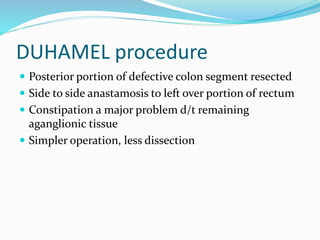Hirschprung's disease
- 1. SARATH T Final year MBBS
- 2. ? Developmental disorder characterised by absence of ganglia in the distal or all part of colon resulting in a functional obstruction. ? Congenital megacolon or congenital aganglionic megacolon
- 3. Epidemiology ? 1 in 5000 live birth ? Boys > girls : 4 ? 3-5% pts have Down syndrome ? Family history ? >95% cases are full term babies
- 4. Etiology ? Ganglion cells are derived from the neural crest ? 12 weeks post conception, neural crest cells have undergone a process of migration through GI tract from proximal to distal, after which they differentiate into mature ganglion
- 5. ? Neural crest cells never reach the distal bcz they mature earlier than they should ? Immunologic mechanism ? Genetic factors ? Deletion in RET gene chr. 10q11 and EDNRB gene located 13q22 and EDN 3 gene
- 6. Zones ? Proximal hypertrophied dilated bowel ? Transition zone ? Distal immobile spastic segment
- 8. Types ? Ultrashort segment HD ? Short segment HD ? Long segment HD ? Total colonic HD
- 10. Associated syndromes ? Down syndrome ? Cat eye syndrome ? Waardenburg syndrome ? Bardet biedl syndrome ? Congenital central hypoventilation syndrome
- 11. Clinical features ? In newborns ? Delayed passage of meconium ? Abdominal distension ? Vomiting ĻC bilious, green ? Neonatal enterocolitis
- 12. ? In older children ? Severe constipation ĻC goat pellet like stools ? c/c abdominal distension ? Vomiting ? Failure to thrive ? On rectal exmn ĻC child passes lot of gas and meconium
- 13. Diagnosis ? History ? Physical examination
- 15. X-rays ? Air fluid level in colon and distended loops of intestine
- 16. Barium enema
- 17. Rectal manometry ? Absence of rectoanal inhibitory reflex ? Lack of internal anal sphincter relaxation in response to rectal stretch
- 18. Rectal biopsy ? Sample of mucosa and submucosa are obtained at 2 cm from the dentate line ? Could be performed at bedside ? Suction biopsy ? Full thickness rectal biopsy is ideal
- 19. Hirschsprung disease: Rectal mucosa (a) showing hypertrophic nerve bundle in the submucosa, increasein Acetylcholinesterase activity (b) of pattern A and negative staining with calretinin (c) note the negative staining of hypertrophic nerve fibre (arrow) with calretinin
- 20. DDs ? Total neuronal dysplasia ? Acquired megacolon ? Anorectal malformations ? Hypothyroidism ? Meconium plug syndrome
- 21. Complications ? Enterocolitis ? Intestinal obstruction ? Growth retardation ? constipation ? Perforation,peritonitis,septicaemia
- 22. Treatment ? Colostomy ? Nutritional supplementation ? Once child attains 10kg wt,definitive procedure is done ? Excision of aganglionic segment ? Maintenance of continuity by coloanal anastomosis ? Closure of colostomy later
- 23. SWENSON procedure ? Sharp extrarectal dissection down to 2 cm above the anal canal. ? Aganglionic colonic segment resected ? End-to-end anastamosis of normal proximal colon to anus via a perineal approach ? Completely removes defective aganglionic colon.
- 27. DUHAMEL procedure ? Posterior portion of defective colon segment resected ? Side to side anastamosis to left over portion of rectum ? Constipation a major problem d/t remaining aganglionic tissue ? Simpler operation, less dissection
- 29. SOAVE procedure ? Circumferential cut through muscular coat of colon at peritoneal reflection ? Mucosa separated from the muscular coat down to the anal canal ? Proximal normal colon is pulled through retained muscular sleeve ? Telescoping anastamosis of normal colon to anal canal ? Advantage: rectal intramural dissection ensures no damage to pelvic neural structures
- 32. Operative complications ? Leak at anastamosis ? Postop enterocolitis ? Stricture formation ? incontinence
- 33. THANK YOU
































